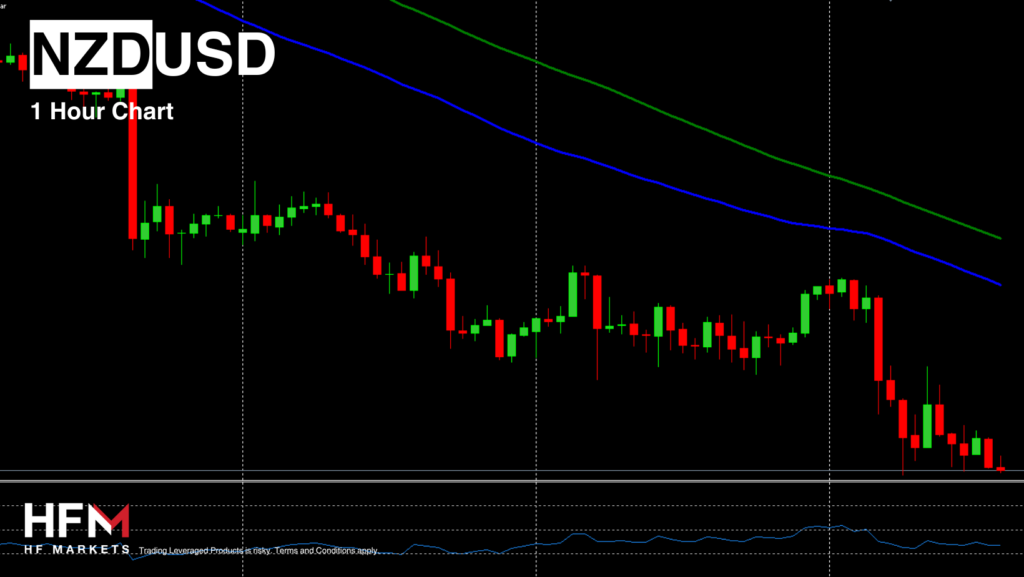- The New Zealand Dollar continues to decline as the Reserve Bank of New Zealand cuts interest rates.
- The market turns their attention to the Federal Open Market Committee’s Meeting Minutes.
- Major central banks are raising the proportion of gold in their foreign exchange reserves including Russia and China.
- US stocks rise ahead of the Fed’s Meeting Minutes and US Inflation data.
NZDUSD – The RBNZ Opt For A SuperCut!
The NZDUSD declined to its lowest level since August 19th after falling a full 1.00% due to changes in the monetary policy. In this morning’s Asian session the Reserve Bank of New Zealand chose to decrease its Cash Rate from 5.25% to 4.75%. As a result, the New Zealand Dollar is the worst performing currency of the day.
Currently the US Dollar Index is trading 0.08% higher and is the second best performing currency after the Swiss Franc. However, the price of the US Dollar will primarily be driven by three factors. The first is tonight’s FOMC Meeting Minutes where investors will be evaluating the report for guidance on the future path of interest rates. The second will be tomorrow’s US Consumer Price Index and Friday’s Producer Price Index. US inflation will also continue to play a key role.
Analysts expect the US inflation rate to fall from 2.5% to 2.3% and for producer inflation to drop to 1.6%. For the US Dollar to hold its position, investors ideally want inflation figures to meet market expectations. If the inflation rate is higher than expectations, the US Dollar can potentially obtain further support. However, if inflation falls below 2.3% and 1.6%, the currency may struggle to strengthen against most others in the short to medium term.
Due to positive US economic data, investors have clearly taken a U-turn on the Federal Reserve’s monetary policy. Previously many market participants were expecting a 0.50% rate cut, whereas, currently they expect a 0.25% cut. According to reports, there is an 11% chance of a pause and 89% chance of a 0.25% cut.
The Fed is becoming more hawkish, while the Reserve Bank of New Zealand takes a different stance. The NZDUSD pair has been steadily declining for the second consecutive week, following the RBNZ’s decision this morning to cut the interest rate. The RBNZ cut to 4.75%, accelerating the pace of policy adjustment from a 25 to 50 basis point reduction. Experts suggest that with inflation slowing to 3.3% YoY in the second quarter and labor market instability, the central bank is likely to continue lowering borrowing costs, further weakening the national currency.
Technical analysis currently indicates the NZDUSD is being controlled by sellers but may retrace in the short-term. The exchange rate is trading below the 75-Bar EMA and the 100-Bar SMA which indicates the price may continue to fall. However, on some timeframes the price remains close to an oversold level and at a lower low. This could prompt a retracement. However, as mentioned above this would also largely depend on the upcoming US data such as the US CPI and PPI.
Click here to access our Webinar Schedule
Michalis Efthymiou
Market Analyst
Disclaimer: This material is provided as a general marketing communication for information purposes only and does not constitute an independent investment research. Nothing in this communication contains, or should be considered as containing, an investment advice or an investment recommendation or a solicitation for the purpose of buying or selling of any financial instrument. All information provided is gathered from reputable sources and any information containing an indication of past performance is not a guarantee or reliable indicator of future performance. Users acknowledge that any investment in Leveraged Products is characterized by a certain degree of uncertainty and that any investment of this nature involves a high level of risk for which the users are solely responsible and liable. We assume no liability for any loss arising from any investment made based on the information provided in this communication. This communication must not be reproduced or further distributed without our prior written permission.




















